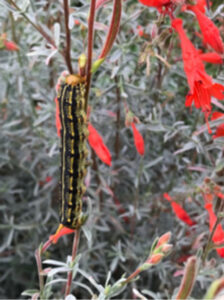Part of an ongoing series about the Seal Beach National Wildlife Refuge
Our visitors to the Seal Beach National Wildlife Refuge arrive with various interests involving the environment, plants, birds, reptiles, mammals, a desire to learn more about the Navy and their relationship with US Fish and Wildlife Service, and for some, curiosity in general. We have shared stories about our aquatic and avian residents. We eagerly await the arrivals of our migratory visitors. Another area of interest centers on the cultural and social impacts of human activity over hundreds of years on this piece of land designated as a refuge in 1972. On our tours conducted by Friends of Seal Beach National Wildlife Refuge, our time spent with our guests is limited and covers a wide-ranging number of topics. Thus, we enjoy sharing life on the refuge through these pages.

A quiet walk along a path may uncover a wide variety of insects, some we might identify by their common, scientific or classification names. While working in our native plant garden, we observe bees performing their pollination activities often within inches of where we are working.
While not a melittologist or apiologist (bee expert), we are learning about their vital role in providing us fruits, vegetables, and various other plants and flowers. After sharing spaces with these critters, one might develop a greater appreciation for their role in this world. Another favorite insect in the garden is the butterfly as we observe its life cycle called metamorphosis. There are so many others that cross our path, some threatening in appearance yet providing another window into the variety and beauty of nature.
The Tadarida brasiciensis or Mexican Free-tailed bat has been observed in the area. This mammal, capable of sustained flight, roosting in buildings with dark recesses, is nocturnal and active between dusk and dawn. Bat boxes have been placed within our garden in the hope of providing a habitat for native species. Our manager has said that he would be surprised if we did not have a bat population. Their role is to help control insects. However, we also have those predators (owls, hawks, and snakes) which feast on bats.
Is our garden a “botanical garden?” Words associated with botanical are “a plant part or extract,” an herb used in skin and hair care, a place to display, study and preserve selected plants.
As we continue to work towards re-imagining this 3-acre treasure following staffing issues, the effects of Covid restrictions, and access concerns, we come to realize that indigenous natives did engage in botanical activities employing native plants. White Sage, if thoroughly washed, was consumed raw or in cooking. Its use as a spiritual smudge to be placed on family, friends, armor and to create a pleasant scent is found throughout the garden.
Black sage would serve similar purposes to white sage with the added relief to alleviate an earache.
Coastal sagebrush is a bush used in basket making, as a bandage for wounds, and as tea. The aroma served spiritual purposes. Later on, it became a “cowboy cologne” used by those riding the range.
Bees cannot see the white or brown varieties of buckwheat flowers but do pollinate the pink variety.
The seeds are mixed with other seeds and may be used to create that favorite pancake or cupcake treat. It can be made into a tea for respiratory issues, headaches and to serve for spiritual ceremonies.
We continue to learn more about our home in Seal Beach. Native plants tell us part of the story and the role they played for our earliest inhabitants.
A review of the literature on native plants reveals the word “monoculture” which can describe how our current lifestyle, economy and practices of consumption may be leading to a further disappearance of the knowledge of early western history regarding bugs, bats, and botanicals.
On this Thanksgiving we give thanks for one another who volunteer on this refuge, for our manager and the leadership of US Fish and Wildlife Service, and for the commitment from the US Navy base leadership in protecting and enhancing this special place.
Joe Lazzari is a member of Friends of Seal Beach National Wildlife Refuge.




